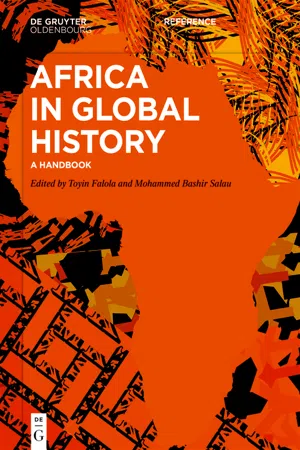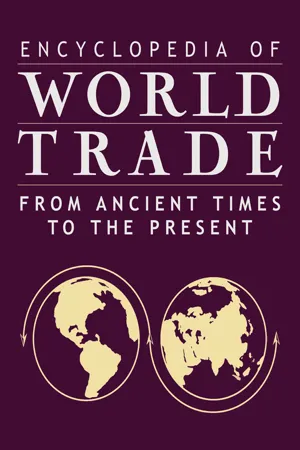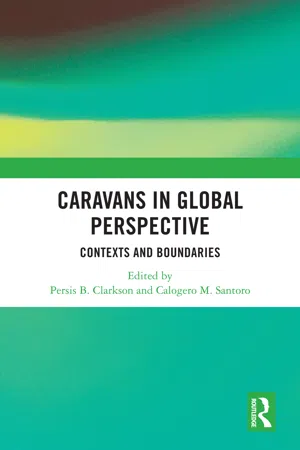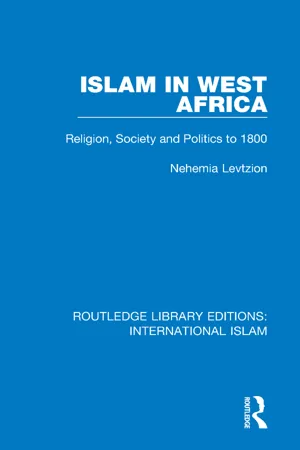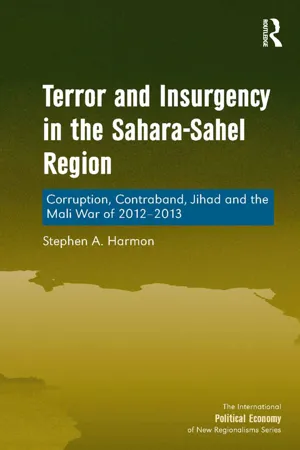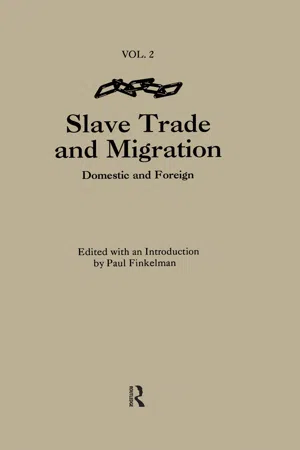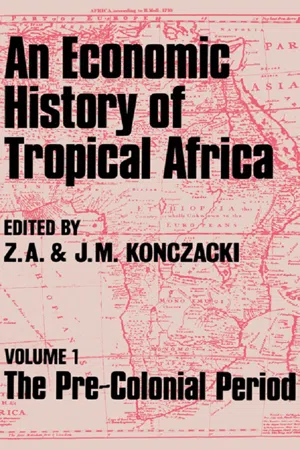History
Trans-Saharan Trade Route
The Trans-Saharan Trade Route was a network of trade routes that connected the Mediterranean coast of North Africa to the sub-Saharan regions. It facilitated the exchange of goods, ideas, and culture between North Africa and West Africa, including gold, salt, ivory, and slaves. The trade route played a significant role in the economic and cultural development of the regions it connected.
Written by Perlego with AI-assistance
Related key terms
Related key terms
1 of 4
Related key terms
1 of 3
11 Key excerpts on "Trans-Saharan Trade Route"
- eBook - ePub
Africa in Global History
A Handbook
- Toyin Falola, Mohammed Bashir Salau, Toyin Falola, Mohammed Bashir Salau(Authors)
- 2021(Publication Date)
- De Gruyter Oldenbourg(Publisher)
Chapter 3 Tran-Saharan Networks to 1800
Moses I. Olatunde IloAbstract
This chapter focuses on the development of a long-distance trade that linked sub-Saharan Africa with North Africa and other parts of the world. The trans-Saharan trade, from earliest times to 1800 identifies important trade routes, articles of trade, markets networks, and commercial networks. The chapter also demonstrates that despite the significance of the relevant commercial networks and the trans-Saharan trade in general, the trade in question gradually declined from the late sixteenth century due to several factors including the rise of the Atlantic trade.Keywords: Commercial networks, trans-Saharan trade, Islam, slavery, ethnicity.Introduction
South of both the Mediterranean Sea and Mediterranean northern Africa lays the Sahara Desert. This desert is greater than the whole of Europe, and it is by far the largest desert in the world. Even though the Sahara Desert is largely characterized by dry sand, it also has mountains and oases that allow for agriculture and sedentary living in several places. Even though the desert presents many obstacles, it could be crossed. Indeed, right from the premodern times, the Sahara Desert became home to major trade routes associated with the famous trans-Saharan trade.1The trans-Saharan trade was mainly characterized by interactions between sub-Saharan Africa and North Africa, but it also fostered connections between Africa and other parts of the world. The trade reached its height in the sixteenth century before experiencing a gradual decline. This chapter examines the factors responsible for the growth and expansion of the trans-Saharan trade. It also discusses the effects of trans-Saharan exchanges and the factors responsible for the decline of the trade. In examining these issues, this chapter demonstrates the importance of the use of camels for transportation, the rise of Islam, and of the development of market and commercial networks as key factors in the expansion of the trade between sub-Saharan Africa and North Africa. In addition, the chapter stresses that the trans-Saharan trade left a complicated legacy and that its decline resulted from several factors including political insecurity as well as the rise of the alternative trade across the Atlantic. - eBook - ePub
Encyclopedia of World Trade: From Ancient Times to the Present
From Ancient Times to the Present
- Cynthia Clark Northrup, Jerry H. Bentley, Alfred E. Eckes, Jr, Patrick Manning, Kenneth Pomeranz, Steven Topik(Authors)
- 2015(Publication Date)
- Routledge(Publisher)
c.e . The reasons behind these forays remain a mystery, but they were probably a mixture of military opportunism and the need for slaves. Roman trade goods, including glass, jewelry, and Roman coins, found at a mountain oasis settlement in the southern SaharaUse of the camel beginning around the first century c.e . helped promote Saharan and trans-Saharan trade. (Library of Congress)dating from at least the fourth century c.e . suggest the extent of trans-Saharan trade.The main routes of the trans-Saharan commerce started from the southern Maghreb towns of Marrakesh, Sijilmasa, Tuwat, Wargla, and Ghadames, which were all linked to ports like Tunis or Tripoli, where swifter naval transport was available toward the East. Through the oases of Murzuk, Ghat, Bilma, and Taghaza, caravans reached their Sudan destinations at Tadmekka, Timbuktu, Awdaghust, Kumbi Sale, Kano, or Kukawa. Trade, however, flowed not just along the shortest North-South axes, but the East-West links toward Egypt and Asia also played an important role. In fact, a continuous eastward shift of the Sudanic centers is discernible. Central Sudanic states, like Wadai, Dar Fur, and Borno, partly owed their growing importance to the lively traffic of pilgrims.The most important development in Saharan trade aside from use of the camel was the gradual introduction of Islam, first to North Africa and then across the Sahara, between the seventh and eleventh centuries. Early Muslim traders established far-flung networks of fellow Muslim agents across the desert and in sub-Saharan Africa in the centuries before larger-scale conversions to Islam. Islam provided a basic shared cultural framework that governed everything from personal behavior to contractual agreements and taxes. This common reference point made trade easier and made Islam attractive to African rulers and other elites. Conversion to Islam provided not only social differentiation but also access to education, favorable trade terms, and access to credit. - eBook - ePub
Caravans in Global Perspective
Contexts and Boundaries
- Persis B. Clarkson, Calogero M. Santoro, Persis B. Clarkson, Calogero M. Santoro(Authors)
- 2021(Publication Date)
- Routledge(Publisher)
Dar al-Islam, certainly played a key role in the establishment of these long-distance gold routes. But despite these ancient contacts that may have been sporadic or even common, it was the strong political pressure of the Middle East that made it possible to build a lasting connection between the Sahel belt and the Mediterranean regions (Haour 2017). The widespread use of the domestic dromedary in North Africa – introduced to the region during the first millennium BC – was, in the course of late antiquity, the final element to establish a traffic system on a continental scale through the now totally desert environment of the Sahara (Almathen et al. 2015:6708).Figure 9.1 Map of Trans-Saharan Trade Routes as mentioned by Ibn Hawqal (tenth century) and Al-Bakrî (eleventh century). Doc. Ch. Capel.The first attempts to open new routes across the Sahara on the fringes of the transversal routes seem to have taken place at the end of the Umayyad era, i.e., around the middle of the eighth century AD; the Arab–Andalusian author Al-Bakrî (eleventh century) echoed this by reporting that ’Abd al-Rahman ibn Habîb, Governor of Ifrîqiya (now Tunisia) in the last years of the Damascus Caliphate, ordered the digging of wells to make a passable route from Tâmdûlt (southwest Morocco) to Awdaghust (south Mauritania) along a north–south axis, near the Atlantic coast (Al-Bakrî 1911:154, 1913:296–297). Whether or not journeys actually occurred under the supervision of the Ifrîqiyan governor, this caliphate project suggests that there were several reasons for creating new routes. The first concerns the practicality and safety of the route to make journeys faster and easier, and thus more enticing and profitable. The aim was to create routes with reliable water sources, secure from raids, accessible to rest stops, and without any dangerous or hazardous crossings. This is why local security conditions were as important as the environmental conditions, and why the chosen routes could quickly shift according to regional realities. The second parameter defining the routes was the location of the production and consumption centers, which were the objective of Saharan crossings. However, these termini evolved over time, depending on the wealth of the political powers who were invested in the trade. Thus, in the Near East, North Africa, and Sahel, geopolitical entities underwent substantial changes between the eighth and the fifteenth centuries, causing a constant displacement of the major power centers, such as Kairouan, Fez, Marrakech, Tlemcen, and Tunis in North Africa; Damascus, Cairo, and Aleppo in the Near East; Gao, Ghana, Mali, and Timbuktu in western Sahel; and Kanem and Borno around Lake Chad, thus directly influencing the layout of major trade routes (Devisse 1972, 1990). But the main criterion for the definition of a caravan route was based upon local resources, on which a large part of trade and travelers’ supplies were based. Above all, a good route consisted of quality stops where competent guides, numerous and robust camels, abundant fodder, and quality and varied goods were available. Therefore, a stopover could become preferred because of a popular local craft industry such as that of the leatherworkers at Zawîla (Libya) (Al-Ya‘qûbî 1892:345, 1937:205), the availability of the famous dates of Ghadâmes (Libya) (Al-Bakrî 1911:182, 1913:340), the precious salt resources of Awlîl (Mauritania) (Ibn Hawqal 1938:92, 1964:89; Al-Bakrî 1911:171, 1913:328), or of renowned prostitution services at Tadmekka (Mali) (Al-Bakrî 1911:182, 1913:339–340). Each one of these criteria could have been a decisive consideration in determining itineraries. - Njoki Nathani Wane(Author)
- 2019(Publication Date)
- Palgrave Macmillan(Publisher)
289). In addition to minor routes, Connah (2004, p. 109) notes three other major trade routes were identified. The first and most well known was the western route running from Morocco to the middle Niger River. Its course, however, varied over time, but the route is often from Sijilmasa in the north, through Taghaza, Taodeni, and Arawan, to Timbuktu in the south. This was the route used to tap and transport the gold from West Africa so it was kept secret by the merchants who dealt in gold in order to gain monopoly over the trade—an attitude which has persisted till today among artisans, tradesmen, and middlemen. The second main routes were the central ones leading from modern Tunisia through Ghadames, Ghat, and Agades to Hausaland in northern Nigeria. At the southern end of this route was Kano which in recent centuries became one of the most important commercial centers in the West African savanna zone. There was also a huge amount of salt from Bilma in the southern Sahara to the north east of Kano. The trade of Hausaland was so important that Hausa became the market language for much of the West Africa savanna. From Tripoli, through Murzuk and Bilma, to Borno in the Lake Chad area lay the third trade route. The principal commodity that was traded and carted on this route was salt from Bilma, but manufactured goods and copper also formed an important part of merchandise. There was a particular demand in the south for horses and in recent centuries, guns. Though there was a demand for other items like ivory, animal skins, and gold, the most important commodity on this route was slaves (Connah 2004, pp. 110–111). This narrative is evident in that the trade routes really crisscrossed and sometimes intersected with each other especially the north-south ones- eBook - ePub
A Different Vision
Race and Public Policy, Volume 2
- Thomas D Boston(Author)
- 2002(Publication Date)
- Routledge(Publisher)
18At the same time, commodity exchanges with the Islamicized Sudan, Bilad al Sudan [Arabic, meaning land of the blacks], were extensive, and the study of the economic life of the great Sudanic empires of Ghana, Mail, and Songhay from the eleventh through the sixteenth centuries is important. With procolonial West Africa, these were complementary economic trade regions, and commerce in the Sudan existed not in isolation from that of the Guinea coastal states, but as a part of an interconnected West African economic unit. As it was, European greed to secure sub-Saharan trade commodities from West Africa, thus avoiding Arab middle men costs, propelled their exploration of Guinea Coast Africa.In his discussion of the economic history of Africa, Ralph Austen describes the degree to which trade connections along the upper Guinea Coast in both precontact and precolonial West Africa had been either established with Sudanic trans-Saharan markets or were integrated into the Sudanic commercial world. As he indicates, the Senegambia-Upper Guinea region was “a direct extension of the Western Sudanic savanna although somewhat distant from its main economic and political centre of the Middle Niger.” The forest regions of the Gold Coast and the Bight of Benin, he adds were “strongly linked to the Sudanic economy but never fully assimilated to it.” Of the remaining three zones, located east and south of the Niger River and its coastal delta, the Bight of Biafra, Gabon-Congo and Angola, Austen said that “Sudanic contacts disappear entirely.”19 - eBook - ePub
The Southern Shores of the Mediterranean and its Networks
Knowledge, Trade, Culture and People
- Patricia Lorcin(Author)
- 2017(Publication Date)
- Routledge(Publisher)
The trans-Saharan slave trade in the context of Tunisian foreign trade in the western Mediterranean Ismael M. Montana Department of History, Northern Illinois University, DeKalb, USAThe paper explores effects of local Tunisian reforms and broader economic and political developments occurring in the western Mediterranean shores during the late eighteenth and early nineteenth centuries on the trans-Saharan slave trade. While the scanty available literature stresses the insignificance of the trans-Saharan slave trade to Tunisia, this paper examines the complex interplay of Tunisian economic reforms and the burgeoning European commercial expansion that shaped the Tunisian economy and, in turn, the trans-Saharan slave trade. Impact of these developments was not limited to Tunisian trade with Europe and the Levant. A significant increase in trade activities between the Regency of Tunis and the African interior can be observed on a number of levels. In particular, aside from the favourable conditions arising from Hammuda Pasha’s reform and economic policies, expanding European trade in Tunisia, mainly after 1788, was a major force behind a continuation and growth of the trans-Saharan slave trade which continued until outlaw in 1841. In addition to Hammuda Pasha’s economic reform policies that led to the integration of the Ghadames caravan trade into burgeoning economy, trade growth between Tunisia and the African interior was further fuelled by European capital infusion in the western Mediterranean.IntroductionBeginning in the late 1780s, the trans-Saharan slave trade from the African interior, while becoming a principal branch of the Regency of Tunis’ network of overland trade, was typically not considered important for burgeoning European commercial expansion that stimulated agricultural production, commerce and Tunisian economy. Nearly a century prior to the late 1780s, the Muradites, who undertook the consolidation of various economic infrastructures following the Ottoman conquest of Tunisia in 1574 (along with corsair expeditions, they developed as a ‘legitimate commerce’ of the Ottoman province), integrated the trans-Saharan slave trade into the nascent Tunisian foreign trade. Successors of the Muradids, the Husaynids (1705–1957), maintained the trade via Ghadames. Until the early 1780s, however, it remained a marginal branch of the Husaynids’ foreign trade. - eBook - ePub
Islam in West Africa
Religion, Society and Politics to 1800
- Nehemia Levtzion(Author)
- 2017(Publication Date)
- Routledge(Publisher)
The limits of each section are sometimes determined by means of transportation: camel caravans in desert, donkeys in the savannah and porters’ heads in the forests. Commercial centres developed along the boundaries between two sections. These centres served as termini of two trading networks, where goods changed hands as well as means of transportation. In the trans-continental African trade system one may discern four sections divided (or, rather, linked) by three lines of commercial centres: a The centres in the southern Maghreb or the northern Sahara — such as Ghadāmes, Nafzāwa, Wārgalān, Tuwāt, Sijil-māsa and Dar’a — about which more will be said in this paper. b The southern termini of the Saharan trade in the Sahel — such as Awdaghust, Walata, Timbuktu, Gao and Katsina, where the camel caravans stopped and Arab and Berber traders exchanged goods with Muslim African traders (Wangara and Hausa). c North of the fringes of the forest, in commercial centres like Bonduku and Salaga, the Wangara and the Hausa, who carried their goods on donkeys, met the people of the forest. Because beasts of burden could not survive south of this line goods were carried on porters’ heads. 13 Each section had its own infrastructure of credit and business transactions. The Geniza documents published and analysed by S. D. Goitein illustrate the operation of a JeWish network, based on kinship and religious ties, between the northern edge of the Sahara and the Mediterranean. Personal relations between partners in Almeria, Fez and Sijilmāsa along one route and Fusṭāṭ, Qayrawān and Sijilmāsa on another route helped solve problems of credit and trust. 14 There was no such infrastructure for Jewish trade in the Sahara. But since the eighth century the Khārijites (mainly but not solely Ibāḍīs) extended their own network from the southern Maghrib (Wār-galān, Tahert, Sijilmāsa and other centres) across the Sahara as far as Tadmekka and Awdaghust - eBook - ePub
Terror and Insurgency in the Sahara-Sahel Region
Corruption, Contraband, Jihad and the Mali War of 2012-2013
- Stephen A. Harmon(Author)
- 2016(Publication Date)
- Routledge(Publisher)
5 Map 1.1 North and West AfricaCredit : Max RinkelAs noted in the preface, the Sahara-Sahel region is also defined by its shared experience with European, especially French, colonial rule and with the decolonization period of the 1950s. Historian Bruce Hall points out how, in a futile attempt to retain a measure of its waning control and influence in Saharan Africa, the French government proposed and supported two failed irredentist schemes, including the Organisation commune des régions sahariènnes (OCRS) and French Saharan Africa (ASF), both of which included all or parts Mauritania, southern Algeria, and the Saharan regions of the French Soudan (Mali), Niger and Chad.6 Though unsuccessful, these schemes highlighted the regional interdependence of the North and West African nations linked by this Saharan and Sahelian core. Both schemes will be discussed further later in this chapter. Historian and Africanist Baz Lecocq, citing a report from a French official of the 1950s, notes, “Arab tribes, including Rgaybat, Tajakant and Berabish tribes, and the Kel Tamasheq [Tuaregs], thought and acted in interlinking networks of commerce, clan, and family affiliation extending from Colomb-Béchar, through Tindouf through Timbuktu and Agadez.”7 The arc thus described extends from the Moroccan border area of Algeria through northern Mali to central Niger, illustrating the nature of the links that bind North and West Africa. Such links were further extended after the drought years of the early 1970s, which severely weakened the pastoral economy of the Saharan Arab and Tuareg populations, forcing many of them to emigrate to, among other places, the cities of southern Mali and to even more distant West African cities as far as Abidjan and Lagos, as well as to Niger and parts of the Maghreb.8 Lecocq also says that since the droughts, the towns of southern Algeria and Libya have been booming, partly because Malian Tuaregs fleeing the drought in Mali settled there and partly because they began to attract labor migrants, mostly from Sahelian and coastal West African countries. Therefore, he notes, Tuareg society has evolved from a “coherent regional base to a diaspora of community pockets around West Africa, the Maghreb and Europe.”9 - eBook - ePub
- Paul Finkelman(Author)
- 2019(Publication Date)
- Routledge(Publisher)
Furthermore, traffic of some kind across the Sahara between North and West Africa had been in existence for something like a thousand years at least before the Arab conquests began in the seventh century A.D. It has been shown, in fact, that a trans-Saharan trade in Negro slaves must have existed, though perhaps in little volume, as early as about the second century A.D. 5 However, we have no means of knowing what relation this may have had to slavery and the slave trade within West Africa itself. In default of evidence of the relation between the existence of an external demand for slaves and of slavery and an internal trade in slaves for the West African Sudan, we must turn to the Guinea area, where commonly the first truly external traders were the European sea-traders, who first arrived on the coasts in the fifteenth century. The evidence for Upper Guinea, from the Gambia to modern Liberia, has been analysed by Dr Walter Rodney. 6 The ethnographic picture that can be built up for this part of the coast-lands from sixteenth- and seventeenth-century European, especially Portuguese, accounts would seem to be good and detailed, but the references to slaves are few and far between. They indicate little more, Rodney says, than that the kings and chiefs of the area had a small number of ‘political clients’ in their households. There is no evidence for the existence of ‘chattel slaves, agricultural serfs, or even household servants’ in any numbers, or in any condition to differentiate them from ordinary citizens. He concludes, therefore, that there was no sizeable class of men, and no indigenous trade in men, which could serve as a launching-pad for the Atlantic slave trade - eBook - ePub
An Economic History of Tropical Africa
Volume One : The Pre-Colonial Period
- J.M. Konczacki, Z.A. Konczacki(Authors)
- 2013(Publication Date)
- Routledge(Publisher)
PART VI
Trade Routes and Trade Centres
Passage contains an image
21
SOME REFLECTIONS ON AFRICAN TRADE ROUTES*
Gervase MathewThere will be four main factors in the reconstruction of pre-European African history south of the Sahara; the recording of oral history, the study of anthropology, archaeological research and geographical analysis, all four must always be co-ordinated, in some instances they will blend.There is none of the northern antithesis between tradition and the written source for normally the few chronicles are essentially segments of oral history recorded at different periods in documentary form as in the case of the chronicles of Kilwa and of Pate. The factual value of traditional history must always depend on the character of the social setting in which it has been preserved, adapted and at times created. In consequence the valid study of oral history is inseparable from scientific anthropology. But it is also interwoven with archaeological research whether the study of sites or of beads or of pottery forms; African tradition has often provided archaeology with its clues as in Uganda. Archaeology is providing the study of traditional history with a new technique for objective checking.But geographical analysis combined with a perpetual awareness of economic factors must give the setting for any reconstruction of the African past. Perhaps the most immediate need is to apply the evidence of oral tradition, archaeology and geography to the re-discovery of pre-European trade routes. There are four main groupings of such routes to be investigated.There are the lines of coastal traffic along the shores of the Indian Ocean and of the Atlantic, and perhaps along the deserts of the Sahara which formed an inland sea. There are the tracks by which exports from far into the interior reached the coast and were ultimately forwarded to foreign markets. There is the network of internal trade within Africa brought into being by local needs for salt or iron or copper. Finally there is the possibility of transcontinen al trade routes. And in each case we are only at the beginning of any scientific study. In this paper I am tentatively making suggestions based primarily on personal experience. - eBook - ePub
- Christina Phelps Grant(Author)
- 2013(Publication Date)
- Routledge(Publisher)
A.D. , but after that the balance was readjusted, owing to the comprehensive domination of the Mohammedans. During the Saracen period, both the North-South and the East-West routes were in constant use, and trade flourished. And after the Ottoman Turks had annexed all former Saracen lands to their empire, then both sets of routes were in use, but neither one of them flourished.HITR.A.F. official photograph : Crown copyright reserved2 THE HISTORICAL BACKGROUND OF CARAVAN TRAVEL BETWEEN SYRIA AND MESOPOTAMIAIn a brief survey of Syrian Desert trade there is no space to include an account of the origins and expansion of commerce in the ancient world, still less an exhaustive analysis of the vicissitudes of trade throughout the centuries. But a sketch of the peaks of commercial prosperity, and their corresponding deeps of decline, is essential in order to enable one to reconstruct a mental picture of when and how these desert routes were used. The accompanying diagram, for example, will serve to focus the commercial periods in their relation to each other, and the periods of maximum and minimum usage of the Syrian Desert as a whole. Then a few words describing the broad outlines of the story of commercial conditions as a whole, and the differing characteristics of the various periods, may give a background for the following chapters which describe in considerable detail several phases of the lives of caravan travellers. When certain of the desert routes were used by the great merchant caravans, and what sort of goods they transported; how the various routes became popular for the use of travellers between the Occident and the Orient, and what their journeys were like; in what way the desert was used by dispatch and mail couriers, to bridge the gap between Mesopotamia and Syria, and to link India with the West; also, and lastly, to give some idea of the modern use of these same routes and the changed conditions of desert travel in the twentieth century.
Index pages curate the most relevant extracts from our library of academic textbooks. They’ve been created using an in-house natural language model (NLM), each adding context and meaning to key research topics.
Explore more topic indexes
Explore more topic indexes
1 of 6
Explore more topic indexes
1 of 4
